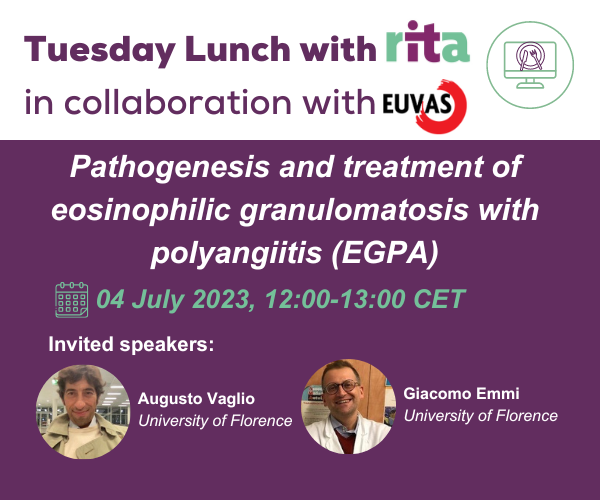Save the Date: Tuesday 04 July 2023, 12:00-13:00 CET
The RITA Education Working Group is happy to invite you to the next Tuesday Lunch with RITA webinar, organised in collaboration with the European Vasculitis Society EUVAS. In this webinar, Dr. Augusto Vaglio (pathogenesis) and Dr. Giacomo Emmi (treatment) will talk about how they treat eosinophilic granulomatosis with polyangiitis (EGPA).
Moderated by: Alfred Mahr and Allyson Egan.
EGPA Pathogenesis
The pathogenesis of EGPA is driven by genetic and environmental factors. Genetic studies have highlighted associations between HLA-DQ and MPO-ANCA-positive EGPA, whereas ANCA-negative EGPA is mainly associated with gene variants involved in mucosal responses and eosinophil biology such as GPA33 and IL5. Several other variants linked to asthma and eosinophil counts in the general population are associated with the whole EGPA spectrum. Among environmental factors, exposure to silica, organic solvents and farming was associated with an increased risk of EGPA, while cigarette smoking with a lower risk. How genetics and environment interact to shape the susceptibility to and the phenotype of EGPA is still unclear.
Several cell types participate in the immunopathogenesis of the disease. Eosinophils are clearly central and are likely to mediate tissue damage, a concept supported by the evidence that targeting IL-5 (eg, using mepolizumab), a survival factor for eosinophils, is an effective therapy for EGPA. CD4+ T-cells orchestrate the adaptive immune response and are polarised toward a Th2 phenotype, which enhances eosinophilic reactions; however, the Th1 and Th17 arms might also play a role, especially in vasculitis and granuloma formation.
In a mouse model of eosinophilic vasculitis, type 2 innate lymphoid cells were key in promoting vascular permeability and secretion of eotaxins, which in turn induce tissue influx of eosinophils. Humoral and B-cell responses are also dysregulated: in addition to the production of ANCA, enhanced production of IgG4 is a common feature of EGPA and probably results from Th2-skewed immunity.
The pathogenic relevance of B cells is also underlined by the good response to B-cell depleting agents (eg, rituximab) in a significant proportion of patients.
EGPA treatment
In this webinar, we will talk about how we treat eosinophilic granulomatosis with polyangiitis (EGPA), discussing the following points:
· New evidence-based guidelines have recently been published for the management of EGPA, addressing remission-induction and remission-maintenance treatment as well as therapies for relapses.
· Remission-induction treatment is tailored based on the presence or absence of organ-threatening manifestations. In patients with severe diseases, cyclophosphamide or, as an alternative, rituximab, should be added to glucocorticoids, whereas in patients with non-severe disease, glucocorticoids alone are generally used.
· For remission maintenance in patients with severe EGPA, rituximab, mepolizumab or traditional DMARDs should be used in combination with glucocorticoids. In patients with non-severe EGPA, glucocorticoids, alone or in combination with mepolizumab, should be used.
· Severe systemic relapses should be treated with rituximab or cyclophosphamide with glucocorticoids, whereas non-severe systemic and respiratory relapses can be treated by increasing the dose of glucocorticoids and/or adding mepolizumab.
· The therapeutic approach should be tailored in special populations such as children, elderly patients, women of child-bearing age and those with comorbidities; conversely, there is no current evidence that different phenotypes (i.e ANCA-positive versus ANCA-negative) need different approaches.
· New therapeutic strategies and sequential treatment (e.g rituximab and mepolizumab) are emerging for treating EGPA.

